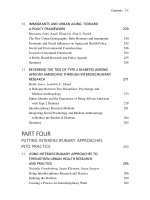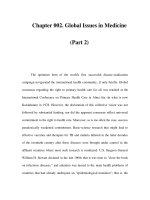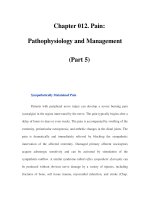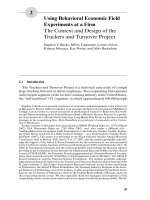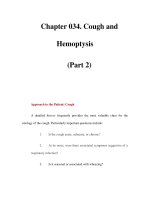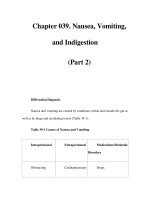Chapter 044. Abdominal Swelling and Ascites (Part 2) pps
Bạn đang xem bản rút gọn của tài liệu. Xem và tải ngay bản đầy đủ của tài liệu tại đây (13.75 KB, 5 trang )
Chapter 044. Abdominal
Swelling and Ascites
(Part 2)
Palpation is often difficult with massive ascites, and ballottement of
overlying fluid may be the only method of palpating the liver or spleen. A slightly
enlarged spleen in association with ascites may be the only evidence of an occult
cirrhosis. When there is evidence of portal hypertension, a soft liver suggests that
obstruction to portal flow is extrahepatic; a firm liver suggests cirrhosis as the
likely cause of the portal hypertension. A very hard or nodular liver is a clue that
the liver is infiltrated with tumor, and when accompanied by ascites, it suggests
that the latter is due to peritoneal seeding. The presence of a hard periumbilical
nodule (Sister Mary Joseph's nodule) suggests metastatic disease from a pelvic or
gastrointestinal primary tumor. A pulsatile liver and ascites may be found in
tricuspid insufficiency.
An attempt should be made to determine whether a mass is solid or cystic,
smooth or irregular, and whether it moves with respiration. The liver, spleen, and
gallbladder should descend with respiration unless they are fixed by adhesions or
extension of tumor beyond the organ. A fixed mass not descending with
respiration may indicate that it is retroperitoneal. Tenderness, especially if
localized, may indicate an inflammatory process such as an abscess; it also may be
due to stretching of the visceral peritoneum or tumor necrosis. Rectal and pelvic
examinations are mandatory; they may reveal otherwise undetected masses due to
tumor or infection.
Radiographic and laboratory examinations are essential for confirming or
extending the impressions gained on physical examination. Upright and recumbent
films of the abdomen may demonstrate the dilated loops of intestine with fluid
levels characteristic of intestinal obstruction or the diffuse abdominal haziness and
loss of psoas margins suggestive of ascites. Ultrasonography is often of value in
detecting ascites, determining the presence of a mass, or evaluating the size of the
liver and spleen. CT scanning provides similar information and is often necessary
to visualize the retroperitoneum, pancreas, and lymph nodes. A plain film of the
abdomen may reveal the distended colon of otherwise unsuspected ulcerative
colitis and give valuable information as to the size of the liver and spleen. An
irregular and elevated right side of the diaphragm may be a clue to a liver abscess
or hepatocellular carcinoma. Studies of the gastrointestinal tract with barium or
other contrast media are usually necessary in the search for a primary tumor.
Laboratory abnormalities that are highly suggestive of cirrhosis as the cause
of ascites include unexplained thrombocytopenia, decreased albumin, and a
prolonged prothrombin time.
Ascites
The evaluation of a patient with ascites requires that the cause of the ascites
be established. In most cases ascites appears as part of a well-recognized illness,
i.e., cirrhosis, congestive heart failure, nephrosis, or disseminated carcinomatosis.
In these situations, the physician should determine that the development of ascites
is indeed a consequence of the basic underlying disease and not due to the
presence of a separate or related disease process. This distinction is necessary even
when the cause of ascites seems obvious. For example, when the patient with
compensated cirrhosis and minimal ascites develops progressive ascites that is
increasingly difficult to control with sodium restriction or diuretics, the temptation
is to attribute the worsening of the clinical picture to progressive liver disease.
However, an occult hepatocellular carcinoma, portal vein thrombosis, spontaneous
bacterial peritonitis, alcoholic hepatitis, viral infection, or even tuberculosis may
be responsible for the decompensation. The disappointingly low success in
diagnosing tuberculous peritonitis or hepatocullar carcinoma in the patient with
cirrhosis and ascites reflects the too-low index of suspicion for the development of
such superimposed conditions. Similarly, the patient with congestive heart failure
may develop ascites from a disseminated carcinoma with peritoneal seeding. It is
important to note, however, that while there are many different causes of ascites,
in the United States >80% of cases are due to cirrhosis. Risk factors for the
development of cirrhosis include alcoholism, viral hepatitis, nonalcoholic
steatohepatitis, and a family history of liver disease.
Diagnostic paracentesis (50–100 mL) should be part of the routine
evaluation of the patient with ascites, and does not routinely require the prior
administration of platelets or fresh-frozen plasma unless disseminated
intravascular coagulation is suspected. The fluid should be examined for its gross
appearance; protein content, albumin level, cell count, and differential cell count
should be determined; and Gram's and acid-fast stains and culture should be
performed. Cytologic and cell-block examination may disclose an otherwise
unsuspected carcinoma. A serum ascites–albumin gradient (SAAG) should be
calculated to determine if the fluid has the features of a transudate or an exudate.
The gradient correlates directly with portal pressure. A gradient >1.1 g/dL (high
gradient) is characteristic of uncomplicated cirrhotic ascites and differentiates
ascites due to portal hypertension from ascites not due to portal hypertension
>97% of the time. Other etiologies of high-gradient ascites include alcoholic
hepatitis, congestive heart failure, hepatic metastases, constrictive pericarditis, and
Budd-Chiari syndrome.
